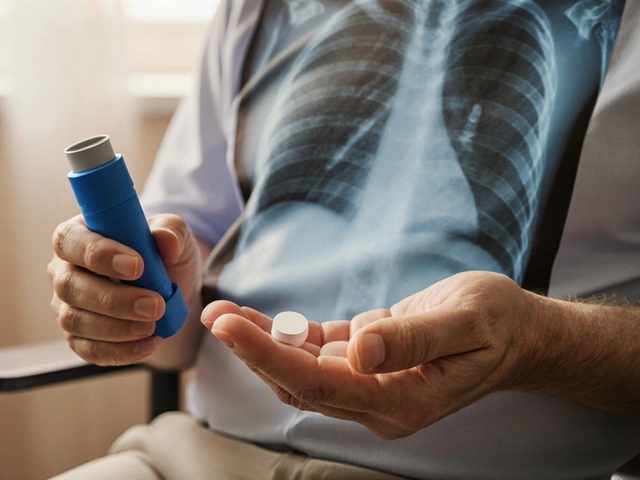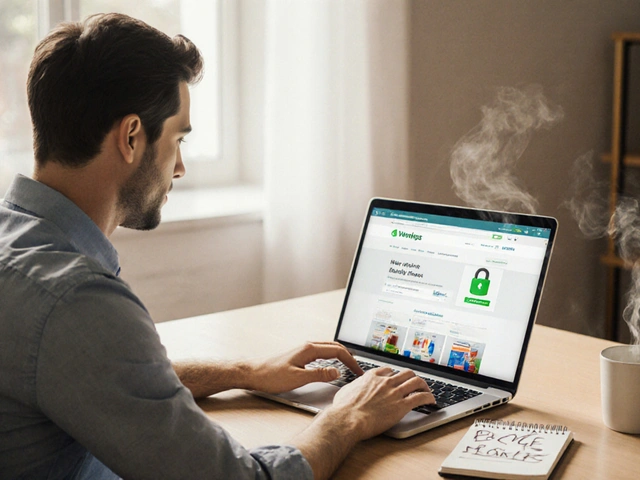Why Your Medication Can’t Handle a Hot Car
If you’re traveling with insulin, Mounjaro, vaccines, or other biologic drugs, you’re not just carrying pills-you’re carrying something that can break down if it gets too warm. The FDA says refrigerated medications must stay between 36°F and 46°F (2°C to 8°C). Go outside that range, even by a few degrees, and you risk losing up to 15% of the drug’s effectiveness every hour. That’s not a small risk. For someone relying on insulin, a degraded dose could mean high blood sugar, hospital visits, or worse.
Most people assume a regular cooler with ice will do the job. But ice melts. Coolers get left in hot cars. Hotel mini-fridges often run at 50°F-too warm for insulin. And if your medication freezes? That’s just as bad. Some biologics turn cloudy or clumpy when frozen, and they’re useless after that.
What Medications Actually Need Cooling?
It’s not just insulin. About 25% of all prescription medications require refrigeration. That includes:
- Insulin (all types, including rapid-acting and long-acting)
- Biologics like Mounjaro (tirzepatide), Ozempic, and Wegovy
- Vaccines (including flu, shingles, and COVID boosters)
- Hormone therapies (growth hormone, some fertility drugs)
- Certain antibiotics and chemotherapy agents
Here’s the catch: Mounjaro can sit at room temperature (up to 86°F) for 21 days. But that’s an exception. Most other drugs, especially insulin, start degrading fast at 77°F. One study showed insulin loses 10% of its potency in just one day at that temperature. If you’re flying to Florida in July or driving through Arizona in August, you’re not just uncomfortable-you’re risking your health.
How Cooling Options Compare: Gel Packs, Battery Coolers, and Fridges
You’ve got three main choices. Each has trade-offs.
1. Pre-Frozen Gel Packs (Budget-Friendly, But Limited)
These come with your medication shipment from pharmacies like CVS or Walmart. They’re cheap and TSA-approved. But they only last 12-24 hours. And if your trip is longer, you need to refill them. That means finding a freezer at a hotel, airport, or gas station. Not always possible.
Field tests show gel packs lose 30% of their cooling power in temperatures above 90°F. And if they’re not fully frozen before you leave? You’re starting behind. Most people forget to freeze them 12-24 hours ahead. That’s a common mistake.
2. Portable Medical Coolers (Best Balance of Power and Portability)
The 4AllFamily Explorer is the most trusted in this category. It’s about the size of a lunchbox, weighs 1.2 pounds empty, and holds up to 7 insulin pens. It uses a special Biogel Freeze Pack that, when pre-frozen, keeps meds at 36-45°F for up to 50 hours-even in 104°F heat.
It also has a USB port. Plug it in at the airport or hotel, and it recharges the gel pack, extending cooling to 72+ hours. No ice needed. No mess. No condensation. And it’s TSA-approved: X-rays see right through it.
Other brands like Armoa offer similar tech but are heavier (6.2 pounds) and cost nearly double. For most travelers, the 4AllFamily model hits the sweet spot: reliable, lightweight, and under $150.
3. Battery-Powered Medical Fridges (For Long Trips or Extreme Heat)
If you’re traveling for 10 days straight or heading into a desert climate, a real mini-fridge might be worth it. The Armoa Portable Medical Fridge runs on battery and keeps meds at a steady 39°F for 48 hours. It’s the only option that actively cools-no ice, no gel packs, no refills.
But it’s bulky (10 x 7 x 7 inches), heavy (4.8-6.2 pounds), and needs 65W power. You’ll need a car adapter or portable power bank. It’s overkill for a weekend trip. But if you’re on a multi-week international journey with multiple injectables? This is your backup lifeline.

What Doesn’t Work (And Why)
Some solutions are dangerous or ineffective.
Dry ice? No. It’s -109°F. It can freeze your insulin solid in minutes, destroying the drug. Plus, airlines ban dry ice unless you’re shipping it as cargo. Not an option for carry-ons.
Regular lunchbox coolers? They’re not designed for medical temps. Most let heat creep in after 12 hours. Condensation forms inside, soaking your pens. And they don’t have compartments to keep meds from touching ice directly-risking freezing.
Hotel mini-fridges? Don’t assume they’re cold enough. Many run at 48-52°F. Test it with a digital thermometer before trusting your meds to it.
Pro Tips from Real Travelers and Pharmacists
Here’s what actually works, based on thousands of traveler experiences and expert advice:
- Freeze your gel pack 24 hours ahead. Don’t wing it. Set a phone reminder.
- Use a waterproof bag. Put your meds in a sealed plastic pouch before placing them in the cooler. This stops moisture from damaging labels or pens.
- Carry a digital thermometer. A $15 device like the MedAngel ONE logs temperature every 5 minutes and sends alerts to your phone. If your meds hit 50°F, you’ll know before it’s too late.
- Call your hotel ahead. Ask for a mini-fridge. 92% of major chains will provide one free of charge if you explain it’s for medical use.
- Bring extra cooling. Pack a second gel pack or ice pack as backup. If your first one melts early, you’ve got a safety net.
- Always carry a doctor’s note. TSA requires you to declare refrigerated meds. A note from your pharmacist explaining the medication and temperature needs cuts screening time by 75%.
- Don’t check your meds. Always carry them in your carry-on. Checked luggage can sit in unrefrigerated cargo holds for hours.
How to Prepare Before You Leave
Follow this checklist before your trip:
- Confirm your medication’s exact temperature range (check the manufacturer’s insert or ask your pharmacist).
- Buy your cooler 1-2 weeks ahead. Test it at home with a thermometer.
- Freeze your gel pack or charge your cooler 24 hours before departure.
- Print or screenshot the manufacturer’s storage guidelines for your medication.
- Ask your pharmacist for a signed letter stating the medication is medically necessary and requires refrigeration.
- Pack a backup cooling solution-even a small insulated bag with two ice packs.
- Set a phone alarm to check your cooler’s temperature every 6-8 hours on long trips.

What to Do If Your Medication Gets Too Warm
If your meds were exposed to heat for more than a few hours:
- Don’t throw them out immediately.
- Check the appearance: Is insulin cloudy or clumpy? If yes, discard it.
- If it looks normal, use it once-but replace it as soon as possible.
- Call your pharmacy or doctor. They may be able to provide a replacement, especially if you have documentation.
Dr. Robert Tomaka, a clinical pharmacist at Memorial Sloan Kettering, says: “Repeated warming and cooling cycles are the silent killer of medication efficacy. Even if the temperature goes back into range, the damage is done.”
Market Trends and What’s Coming Next
The market for travel coolers is growing fast. More people are on biologics-42% of new FDA-approved drugs in 2022 were biologics. That’s up from 28% in 2018.
Companies are responding. The 4AllFamily Explorer 2.0, released in October 2023, now includes Bluetooth alerts. If your meds go above 48°F, your phone pings you. MedAngel’s new CORE system promises 120 hours of cooling, but early tests show it struggles in tropical heat.
Pharmaceutical companies are also stepping up. 78% now offer companion apps that track your medication’s temperature history. That means if you ever need to prove your meds were stored correctly, you’ve got digital proof.
But the biggest change? Hospitals and insurers are starting to provide free travel coolers to patients. In 2019, only 12% of major healthcare systems did this. Now, it’s 41%. Ask your pharmacy or provider-you might qualify.
Final Thought: It’s Not About Convenience. It’s About Safety.
Traveling with refrigerated meds isn’t a hassle. It’s a necessity. The tools exist. The knowledge is out there. What’s missing is the habit.
Don’t wait until you’re at the airport, sweating in a line, realizing your cooler is warm. Plan ahead. Test your gear. Carry backup. Know your meds. Your health depends on it-not on luck, not on hope. On preparation.






Just threw my insulin in a cooler with ice and called it a day. 🤷♂️ Turns out I’m a walking medical disaster. 🥶💊
This whole ‘refrigerated meds’ thing is a Big Pharma scam to sell you overpriced gadgets. Your body doesn’t need perfect temps-it needs faith. And maybe a prayer. The FDA? Controlled by the same people who told you vaccines were safe. Wake up.
Ah, the sacred calculus of molecular integrity. The biologic-once a living whisper of divine chemistry-now reduced to a temperature-dependent slave of corporate logistics. We’ve turned healing into a spreadsheet. The gel pack is our new sacrament. The USB port, our altar. And still, we kneel. What is a human if not a vessel for the cold, silent rage of pharmaceutical entropy?
In India, we use coolers with ice and wrap the vials in cloth. Simple. Effective. No fancy gadgets needed. Many people here manage without expensive gear. Maybe it’s not about the tech-it’s about knowing your meds and being careful.
The 4AllFamily cooler? Overrated. I’ve seen three of these fail during a 10-hour flight. The Biogel pack? More like ‘Biogel lie.’ And don’t get me started on the ‘TSA-approved’ marketing-that just means they didn’t explode in the X-ray. Doesn’t mean it works. You’re being sold a placebo with a USB port.
I just want to say how much I appreciate this post. I’ve been traveling with insulin for 12 years now, and honestly? I never knew about the hotel fridge thing. I thought they were all cold enough. I even left my pen in one once and didn’t realize it was at 50°F until my glucose spiked. I cried that night. Not because I was scared-I was just so tired of having to be this careful all the time. Thank you for saying what so many of us feel but never say out loud. You’re not alone. I’m here. We’re all here.
I bought the 4AllFamily cooler last month and it’s been a game-changer. 🎉 Used it on a road trip to Arizona-110°F outside, meds stayed at 41°F the whole time. Also, the Bluetooth alert? Saved me when my phone died and I didn’t notice the temp creep. Honestly? Worth every penny. No more panic at gas stations. 😌
I’m so glad someone finally made this easy to understand. My mom has type 1 and we used to stress every time we traveled. Now we carry two gel packs, a thermometer, and her doctor’s note. She says it feels like she has a safety net. That’s more than I ever thought possible. 🤍
There is a metaphysical truth here, buried beneath the plastic and lithium-ion: the modern human has become a custodian of fragile life, not through grace or wisdom, but through bureaucratic necessity. We are no longer patients-we are logistics operators. Our insulin pens are not medicine; they are relics of a dying covenant between biology and commerce. And yet, we carry them. We charge them. We pray to their temperature logs. What does this say about us? That we have outsourced our vulnerability to a device? Or that we have, finally, learned to love our bodies enough to protect them-even from ourselves?
I’ve tested three different coolers over the past year-4AllFamily, Armoa, and a generic one from Amazon-and honestly, the 4AllFamily is the only one that consistently held 39°F for over 48 hours in 95°F heat. I used a MedAngel thermometer to verify every single time. The Armoa? Great specs, but the battery died after 36 hours on a flight. And the Amazon one? Condensation soaked my pens. I now carry the 4AllFamily + a backup gel pack + my doctor’s note. It’s not ‘overkill’-it’s insurance. And if you’re not doing this? You’re gambling with your life. I’ve seen people lose vision from degraded insulin. Don’t be that person.
The assertion that hotel mini-fridges are unreliable is not universally accurate. Many properties, particularly those under Marriott, Hilton, and Hyatt, maintain strict temperature controls for medical guests. It is incumbent upon the traveler to request documentation from the front desk regarding the unit’s calibration. Relying on anecdotal evidence is poor practice.
So you’re telling me I need to spend $150 on a lunchbox with a USB cord… just so my insulin doesn’t turn into soup? 🤭 I’m just gonna carry it in my pocket and hope the sun doesn’t notice. 😘
I think this whole thing is a distraction. The real issue? The government and pharma want you dependent on their gadgets. They don’t want you to know that cold temperatures are just a myth created to sell coolers. My cousin in Delhi uses a wet towel and a bamboo basket-his insulin lasts 72 hours. Why? Because nature knows better than science. The FDA is just scared of people finding out the truth. And the Bluetooth alerts? That’s surveillance. They’re tracking your blood sugar. Don’t fall for it.